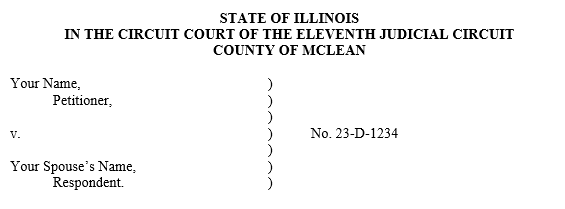Child custody battles can be emotionally charged and legally intricate affairs. When navigating such difficulties, a well-crafted affidavit can serve as a powerful tool to present your case. An affidavit is a sworn statement in writing, made under oath or affirmation, and it can play a crucial role in influencing the court’s decision. In this guide, we will walk you through the essential steps for how to write an affidavit for child custody to help you present your case in the best possible light.

1. Understand the Purpose of the Affidavit
Before diving into the details of drafting your affidavit, it’s essential to understand its purpose. An affidavit serves as your written testimony, providing the court with a firsthand account of the facts and circumstances surrounding the child custody case. It should be structured in a way that clearly and persuasively presents your perspective. Typically, this means the affidavit will be in chronological order so it can effectively walk the court through your evidence. To learn more about evidence in family courts check out “How To Present Evidence In Family Court In Illinois.”
You can typically find free forms or templates on your local county courthouse’s website that can help you draft an affidavit. Keep reading to learn how the affidavit is supposed to be filled out, and how to draft an affidavit from scratch.
2. Begin with a Clear Heading
Start your affidavit with a clear and concise heading that includes the case title, court name, case number, and the parties involved. This sets the stage for a professional and organized document. You can always find forms online for your specific jurisdiction. The heading should look like this:

If your spouse was the one that initially petitioned the court for divorce, then their name would be first since they would be the petitioner in this scenario. You should already have a case number assigned to your case after the initial petition is submitted.
3. Introduction: Identify Yourself and Your Relationship to the Child
In the opening section, you should introduce yourself and establish your relationship with the child. Clearly state your name, address, occupation, and how you are related to the child in question. If you are a parent, specify your relationship as “father” or “mother.” The opening should look something like this:
I, (your name), being first duly sworn, depose and say:
- I am the (mother/father/legal guardian) of (child’s name), born on (birth date).
- I have been the primary caregiver for (child’s name) since (date), and I have a close and loving relationship with (child’s name).
- I am financially stable and able to provide for (child’s name)’s physical and emotional needs.
What follows should include more specific information related to your case including evidence that you are a good parent and that your child should stay with you instead of your spouse. Each allegation (each point you want to make) must be numbered. Make sure to include only one allegation per statement and keep them numbered like above. Keep reading to learn more.
4. Provide a Brief Background
Offer a brief overview of the relevant background information, such as the history of your relationship with the child, living arrangements, and any significant events that led to the current custody dispute. Be factual and stick to the details that directly relate to the case. You should include dates, times, locations, and any other information that may be relevant to the custody dispute. Being as specific as possible will help articulate your points. Being specific will also help you fight false allegations. If you are worried your spouse might lie under oath, check out “How To Fight False Allegations In Child Custody.”

5. Detail Your Involvement in the Child’s Life
After including relevant background information, you should detail your involvement in your child’s life. Outline your active involvement in the child’s life, including daily routines, educational activities, extracurricular activities, and any special bonding moments like vacations or birthdays. This section should emphasize your commitment to the child’s well-being and highlight your ability to provide a stable and nurturing environment. While being able to provide financially for your child is important, this section should focus on you as a parent, and your relationship with your child.
6. Address the Best Interests of the Child
Courts make decisions based on the best interests of the child. To ensure you are given custody or visitation rights, you should articulate why awarding you custody is in the best interests of the child. Reference factors such as your ability to provide emotional support, a stable home environment, and a positive upbringing. It’s crucial to align your arguments with the legal criteria the court considers when determining the child’s best interests.
7. Include Relevant Supporting Documentation
Attach any relevant supporting documents, such as character references, school records, medical records, financial records, or statements from witnesses who can attest to your capabilities as a parent. These documents add credibility to your claims and provide tangible evidence for the court to consider. The more evidence you can include that is relevant and authentic, the better your affidavit will be.
It is important to note that some evidence may not be admissible because of some objectionable material. You should limit out of court statements from people other than your spouse unless they draft an affidavit as well. A qualified family law attorney will help you draft an affidavit that is not objectionable. To learn more about what constitutes evidence in family court, check out “Can I Use a Voice Recording as Evidence in Family Court in Illinois?”

8. Be Honest and Concise
While it’s essential to present your case persuasively, honesty is paramount. Stick to the facts, avoid exaggerations, and be concise in your statements. A clear and truthful affidavit is more likely to be viewed favorably by the court. The last sentence of your affidavit should be:
“Under penalties of perjury, I hereby declare and affirm that the above-mentioned statement is, to the best of my knowledge, true and correct.”
Once your affidavit is drafted, it must be notarized. Signing your affidavit in front of a notary certifies the document and seals your oath to be truthful. If you are not honest and truthful in your affidavit, there will be serious legal consequences.
Conclusion: How To Write An Affidavit For Child Custody
In conclusion, crafting an effective affidavit for child custody requires a careful balance of factual information, legal considerations, and persuasive storytelling. By following these guidelines and seeking guidance from your attorney, you can create a compelling document that strengthens your case and contributes to the court’s understanding of your suitability as a custodial parent. Remember, each case is unique, so tailor your affidavit to the specific details and circumstances surrounding your child custody dispute.
MEET WITH AN ILLINOIS FAMILY LAW ATTORNEY TODAY
The Family Law attorneys at Koth Gregory & Nieminski understand that your family is the top priority, which is why we offer SAME-DAY APPOINTMENTS. If you need a divorce or other family law services, you can schedule your first meeting through our online appointment calendar. We look forward to meeting you.
Disclaimer: This article (How To Write An Affidavit For Child Custody) may contain information that is outdated as Illinois law continuously evolves. Meeting with an experienced family law attorney is the best way to ensure you are receiving the most current information about How To Write An Affidavit For Child Custody.

Published by Dustin Koth on December 10, 2024
